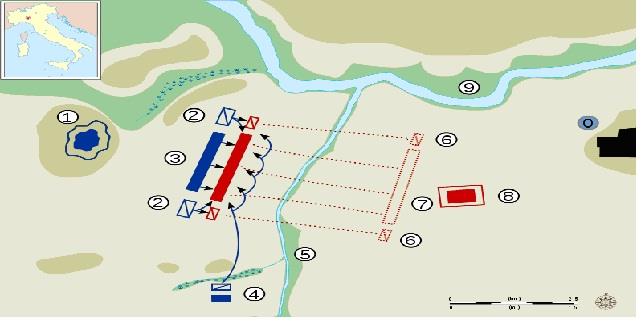Origins
Piacenza, a city in the Po Valley, is located on the right bank of the Po River, at the confluence to the west of the Trebbia River and to the east of the Nure Torrent. Its geographical position has always been strategic in military terms and has led to its position today as an important railway and motorway hub. Populated right from ancient times, the city of Piacenza was founded on the banks of the Po River in 218 BC, probably on a previously existing Celtic establishment. The Romans founded the city as an outpost for the incumbent threat of a second Punic war with Hannibal, to consolidate conquests in Gallic territory and ward off the Celts.
Battle of the Trebbia
The Battle of the Trebbia, which took place on 18 December of 218 BC during the second Punic war, was the second battle engaged on this side of the Alps between the Roman legions of the consul Tiberius Sempronius Longus and the Carthaginian legions led by Hannibal. After having won the Battle of the Ticinus, with a disastrous outcome for the Roman legions, Hannibal got ready to conquer these zones. Once he had taken Clastidium (now known as Casteggio) by force, Hannibal also won the Battle of the Trebbia, during which about 20,000 soldiers were killed. Put Placentia – as Piacenza was then called – resisted successfully: the marshy land was drained, the production of wheat, barley and millet was increased and waving of wool was also started. The city thus became an important Roman municipality with an active port on the Po River during the period of the Republic and Empire.

From the fall of the Western Roman Empire to the start of the year 1000.
It was indeed in Piacenza, in 476 AD, that the historical cycle of the Western Roman Empire ended with the killing of the general Flavius Orestes and subsequent overthrowing of the last emperor, Romulus Augustus, by Odoacer, the king of the Herulians. After the fall of the Roman Empire, the city was sacked twice and then reconstructed following the barbarian invasions. It found itself at the centre of the war between the Goths and the troups of the Eastern Roman Empire.
The city’s fate improved when it became the seat of Lombard nobility (i.e. when the seat of a Lombard duchy was established there), but only with its domination by the Franks in the 9th century was the city really reborn.
Piacenza became increasingly important as of the year 1,000, when it enjoyed population and economic growth, aided by its location on the Via Francigena, which brought numerous pilgrims and merchants to the city.
In 1095 Pope Urban II held the major Council of Piacenza, in which the pleas for help from the Emperor of Constantinople against the “infidels” was read. The place of this event can be identified today in Piazza delle Crociate (= Crusade Square), in Via Campagna.
The annextion to Italy
On 10 May 1858, with a plebiscite, Piacenza applied for annexation to the nascent Kingdom of Italy, then still known as the Kingdom of Sardinia. On 14 May a delegation consisting of illustrious city people, delivered the results of the plebiscite to King Carlo Alberto, who was camped near Verona. The monarch thus proclaimed Piacenza the “Primogenita dell’Unità d’Italia” (= the first-born city of the Unification of Italy) – a title of which the city is still very proud today.